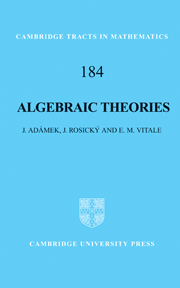Book contents
Appendix C - More about dualities for one-sorted algebraic categories
Published online by Cambridge University Press: 01 June 2011
Summary
Throughout the book, we took the “strict view” of what a theory morphism or concrete functor or monadic functor should be; that is, the condition put on the functor in question was formulated as an equality between two functors. There is a completely natural nonstrict view wherein the conditions are formulated as natural isomorphisms between functors. This has a number of advantages. For example, we can present a characterization of one-sorted algebraic categories (see Theorem C.6) for which we know no analogous result in the strict variant. Also, the duality between one-sorted algebraic theories and uniquely transportable one-sorted algebraic categories can be directly derived from the nonstrict version of the biduality 11.38 without using monads. In this appendix, we briefly mention the nonstrict variants of some concepts in the book.
Definition
Given concrete categories U: A → K and V: B → K by a pseudoconcrete functor between them, we mean a functor F: A → B such that V · F is naturally isomorphic to U.
Given concrete categories U: A → K and V: B → K by a pseudoconcrete equivalence between them, we mean a functor F: A → B, which is at the same time an equivalence and pseudoconcrete. (Note that any quasi inverse of F is necessarily pseudoconcrete.) We then say that (A, U) and (B, V) are pseudoconcretely equivalent.
Definition A concrete category (A, U) on K is pseudomonadic if there exists a monad M on K and a pseudoconcrete equivalence A → KM.
- Type
- Chapter
- Information
- Algebraic TheoriesA Categorical Introduction to General Algebra, pp. 232 - 240Publisher: Cambridge University PressPrint publication year: 2010



